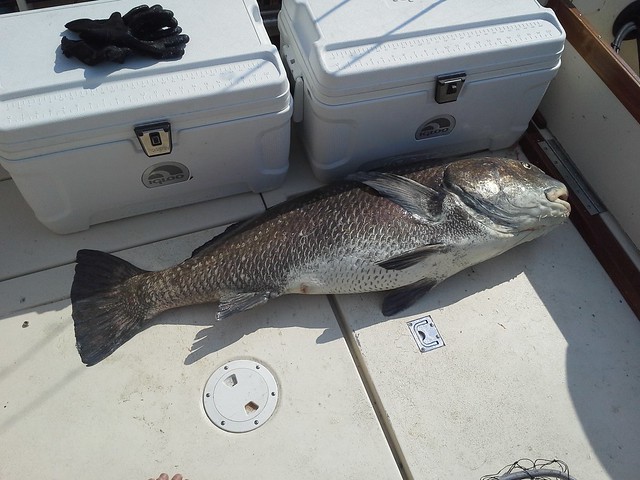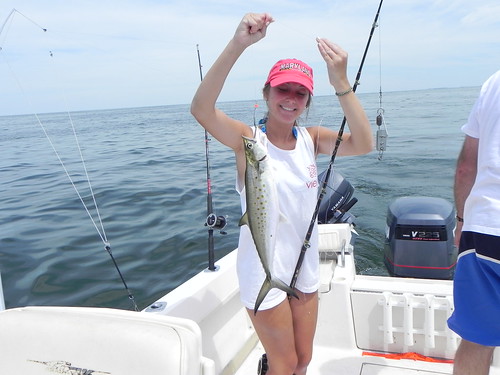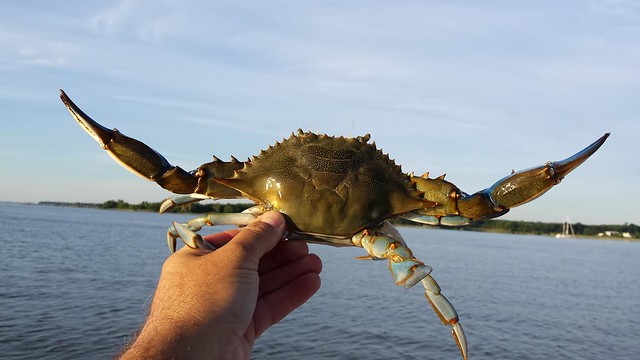By: Keith Lockwood
It is in the nature of fishermen to notice things concerning fishing, this leads to day dreaming while we are involved in our travels. This could occur while sitting at the airport waiting for a flight or driving on the highways. A fishing rod case will catch the eye of any angler at the airport, and who does not start day dreaming when they see a canoe and a vehicle full of camping equipment and fishing gear while traveling on an interstate? These sights bring us to dream of our own past adventures or perhaps inspire us to make the time to plan a new one of our own. We all know life is short, and it needs to be lived to the fullest; so try to break free from the daily routine and plan your next fishing adventure, even if it's close by, and take advantage of the many fishing opportunities Maryland has to offer.
The upper bay region holds a lot of possibilities this week for anyone looking to catch striped bass. The fish continue to be in residence at Swan Point, Love Point, and Podickory Point. In addition to these favorite spots, there are many other locations in the upper bay worth taking a look at. Chumming and live lining spot are the standard fare at the traditional locations on a good tide. The fishing success continues to be very good this week with live lining spot offering some of the best opportunities for a nice grade of striped bass. There are other locations that can produce good action at times without the crowds; it just takes a little exploring and in fact many of these locations are well known to seasoned locals. The steep channel edges around Hart Miller Island have always drawn a small gathering of those who live line eels and I would think live spot would do just fine also. The old piers near the Key Bridge are a good place to find striped bass and also white perch. Channel edges at the very top of the bay and the mouths of the region's tidal rivers are also a good place to check, look for structure. Some of these places offer good action in the early mornings and evenings with topwater lures and other times jigging or even trolling can pay off.
White perch fishing continues to be good in the upper bay region near structure such as old piers, rocks, prominent points and shoals or reefs out in the bay. When fishing near shore side structure, small spinners and jigs with ultra light tackle can offer a lot of fun fishing and some large white perch. Out at the knolls, shoals and reefs in the bay or in the tidal rivers, bloodworms on a bottom rig or jigs and dropper flies fit the bill. As often is the case one location may be holding nice perch and another location small perch. Croakers and spot can also be part of the mix at times and of course there are small bluefish and cow-nosed rays roaming through the region.
The Bay Bridge continues to be a fixture when it comes to fishing. There are striped bass suspended near bridge piers, abutments and rock piles along with white perch in the shallower areas. Chumming, chunking, live lining and jigging are all good methods to get in on the action when the tide is running for striped bass. The white perch can be caught on jigs with a dropper fly or a bottom rig baited with bloodworms or peeler crab. There are also some spot being caught in the shallower areas of the bridge and also in the mouth of the Magothy River. Andy Bibo was bottom fishing at the mouth of the Magothy with peeler crab for bait when he got a bit of a surprise on the end of his line. After a long tussle he managed to bring this 90 lb black drum into the boat and also gained entry into the Maryland Fishing Challenge with this 48" catch.

Photo courtesy of Andy Bibo
The Kent Narrows has been a great place to catch white perch lately by using small jigs cast from the bulkheads in the evening hours when boat traffic subsides. Cast at a 60° angle up current and when your jig hits the bottom at a 90° angle; you start gently bouncing the jig along the bottom till it swings parallel to the current. Small striped bass will be part of the catch also, and anglers should carefully unhook them and quickly return them to the water. Recently a few guys from the western shore found out the hard way from the NRP that it is greatly frowned upon to keep undersized striped bass.
There is plenty of striped bass action at traditional channel edges in the middle bay region. The outside edge of the Hill, Hacketts and edges such as Tolleys, Thomas Point, Bloody Point and inside Eastern Bay can also hold striped bass. This usually depends on the tide and whether bait is present. A good depth finder is a valuable partner when searching for suspended fish near structure. A few boats are still chumming but just about everyone is live lining spot. Spot are being found at various shallow reef areas but the inside of Hacketts and the mouth of the Choptank have been two of the more consistent places to obtain them. Expensive bloodworms are what it takes to catch them and if you mix a couple of cut up nightcrawlers in with the bloodworm juice on the bait board you can stretch out your bait supplies.
There are a few croakers to be found in the middle bay region with most of the action occurring on channel edges at dusk. Small bluefish seem to be everywhere and the Spanish mackerel action has picked up. Trolling has been the primary way to target the Spanish mackerel and bluefish and small Drone or Clark spoons behind planers has been the best way to target them. The deadly duo has been chasing bay anchovies along the edges of the channels where swift currents tend to push the bait along. At times depth recorders will reveal "false bottoms" of bait below or breaking fish on the surface can be spotted. More than a few have been placing larger spoons in their trolling spread and finding some catch and release action with large red drum along channel edges. Also if you are looking for bluefish for your smoker placing some red surge tube lures in your spread is a good idea.
The Maryland Artificial Reef Initiative deployed an additional 100 tons of concrete that was donated by Dominion Cove Point on Sunday at the Taylor's Island reef site. The large pieces of concrete were salvaged from the foundations of some demolished buildings at the Cove Point site. This was the 4th load of 5 loads of material that will be deployed at the site this summer to enhance fish habitat.

Photo courtesy of Erik Zlokovitz
Shallow water fishing for a mix of striped bass and white perch continues to be a fun option for those that can get up early or have time to hit the water in the evenings. Topwater lures are often the best bait and certainly offer the most entertainment. You can work them over grass and shoreline structure such as submerged rip rap, assorted rocks and sunken wood. The white perch can be caught on lighter tackle and casting ¼ ounce spinners, spinnerbait type lures and small swim shads and similar type lures offers some fun ultra-light tackle action and some fine eating when you can find the larger perch.
Lower bay region fishing has been focused to a great extent on trolling, chasing breaking fish and bottom fishing. Those that are trolling report a larger class of bluefish moving into the region, often around 20" in length. Spanish mackerel have arrived in good numbers and the shipping channel edge between Cedar Point and Cove Point has been one of the best places to catch them. Red surge tubes and spoons behind planers or inline weights have been a good choice for catching bluefish and often larger spoons can get you in on some large red drum catch and release action. The Middle Grounds, the mouth of the Potomac and the shipping channel edges have been good places to target bluefish. When it comes to Spanish mackerel it is hard to beat small Drone and Clark spoons towed behind planers to get the job done. This nice Spanish mackerel fell for a Clark spoon behind a planer.

Photo courtesy of Sheri Conley
There is a lot of bait in the form of bay anchovies in the region and as they are swept along steep channel edges where currents gain power; a mix of bluefish and spanish mackerel are making short work of them, often on the surface. It is not uncommon to find some striped bass underneath all of the surface mayhem waiting for tidbits to rain down from above. Casting metal jigs can get you into the surface action and to deeper prospects as it sinks to deeper depths.
Bottom fishing for a mix of croaker, large spot, white perch and small bluefish continues to be very good in many areas of the lower bay region. The eastern side of the bay is offering good fishing for croaker, spot, white perch, bluefish along with sea trout and kingfish thrown into the mix. There have also been a few flounder being caught by those who are targeting them in the Pocomoke/ Tangier Sound area. On the western side of the bay; the lower Potomac and Patuxent Rivers have been offering very good fishing for croakers, spot and white perch. Channel catfish can be part of the mix in the Patuxent River and Blue catfish in the Potomac.
Recreational crabbers continue to enjoy good crabbing in most areas of the bay. The upper bay is beginning to show better crabbing in the tidal rivers and even up by the Elk River where crabs are prone to arrive via the C&D Canal. The middle and lower regions of the bay hold the best opportunities for filling a bushel basket of large heavy crabs. Trot liners have been experiencing some difficulties with crabs dropping off as boats swing in the recent winds but are still able to do well. Those using collapsible traps of course do not have that problem. Deep waters in the 16' to 20' range tend to give up the largest crabs and the shallows tend to be crowded with sooks and sub-legal crabs. There is a big molt on the horizon in about a week or so and after the normal abundance of light crabs they will begin to fill out quickly and September should be a great month for family crab feasts and stocking up the freezer with a winter stash of crab meat.

Photo by Rich Watts
Freshwater fishing continues this week with a steady summer mode of fish behavior not totally unlike our own. Most freshwater fish are most active during cool and low light times of the day. Just about every fish from trout in the central and western regions of the state to some of the most popular species such as largemouth bass tend to sit out the hot and sunny periods of the day and look for a bite to eat late in the evening to the early morning hours.
At Deep Creek Lake those getting out on the water at day break are finding some walleye and trout action down by the dam by slow trolling or drifting deep with worm rigs or live minnows. The floating docks along shorelines have largemouth and smallmouth bass hanging around them depending on the depth of the water. Various soft plastics and tubes are a good choice for targeting them. The shallower coves offer fishing for largemouth bass, chain pickerel and northern pike near or in the grass that grows there. Plastic frogs are a good choice for fishing over the thick mats of grass.
The many impoundments that dot the Maryland landscape hold all kinds of fishing opportunities this time of the year. Largemouth bass are one of the top targets, but bluegills, crappie, chain pickerel all can provide plenty of great fishing fun, especially for the younger set. The tidal rivers and small ponds on the Eastern Shore hold a lot of peaceful fishing opportunities since they usually do not get as much attention as the western shore areas. Many of these waters can be accessed by launching a canoe or just fishing from shore and if they've never been fished before hold that element of exploration. This happy angler holds up a nice largemouth bass caught and released from a southern Maryland pond.

Photo courtesy of Peter Cannavino
The tidal rivers on both the eastern and western side of the bay offer good opportunities for largemouth bass as well as species such as blue catfish and northern snakeheads in the tidal Potomac and channel catfish in most other tidal rivers feeding into the Chesapeake. A falling tide is the best time to target these grassy areas in the early morning and evening hours for largemouth bass. The upper reaches of the tidal rivers and creeks on the lower Eastern Shore are offering more and more northern snakehead action as the species expands its range. The Susquehanna Flats area has good largemouth bass fishing in the thick grass areas; casting frogs on top of the grass has been one of the better ways to catch them. There has also been some smallmouth bass action in the lower Susquehanna River late in the day when the Conowingo Dam is releasing water for power generation; topwater lures have been a favorite way to catch them.
Ocean City area fishing is of course moving into a late summer phase now and all of our typical summer migrants tend to be in town and a few less common ones as well. It is not all that uncommon to see species such as jacks, juvenile grouper, puffer fish and other southern species that follow the warm water northward. If we get a tropical storm or hurricane there often will be an additional surge in species folks are not familiar with.
The surf fishing scene is mostly centered on fishing for kingfish and croakers in the mornings and evening with bloodworm or squid baits. There is some inshore shark action also in the evenings for those soaking larger baits of menhaden. Remember that protected sharks must not be hauled up on the beach for pictures before being released; they must remain in the water while being unhooked.
In the inlet and Route 50 Bridge area flounder fishing has been good but there are a lot of throwbacks. There are some triggerfish and sheepshead around the jetties and sand fleas and squid are good baits to use for them. Small bluefish continue to move in and out of the inlet with the tides and some striped bass and sea trout are being caught. In the back bay channels croakers and flounder are the main target for fishermen.
Outside the inlet there are some nice flounder being caught on the shoal areas on Gulp baits and everyone should keep an eye out for big cobia because they are out there. Dan Imhoff was drifting for flounder with a 5" Gulp when he caught this 73 lb cobia. Out at the wreck and reef sites rail huggers are catching big flounder and with sea bass and triggerfish mixed in.

Photo Courtesy of Dan Imhoff
The offshore areas from the 30 fathom line out to the canyons are providing a wide mix of species. Small dolphin are a very common catch with some nice gaffer sized ones mixed in. Yellowfin tuna are a big part of the mix and they can range from "just legal" size to 65lb plus. White marlin are providing plenty of action with the promise of blue marlin. Bigeye tuna are being caught and wahoo have been a very welcomed addition to the summer fest. Deep drop fishing for tilefish has been rounding out trips for those that stop for the action on the edges of the canyons.
Boom...Morgan
No comments:
Post a Comment